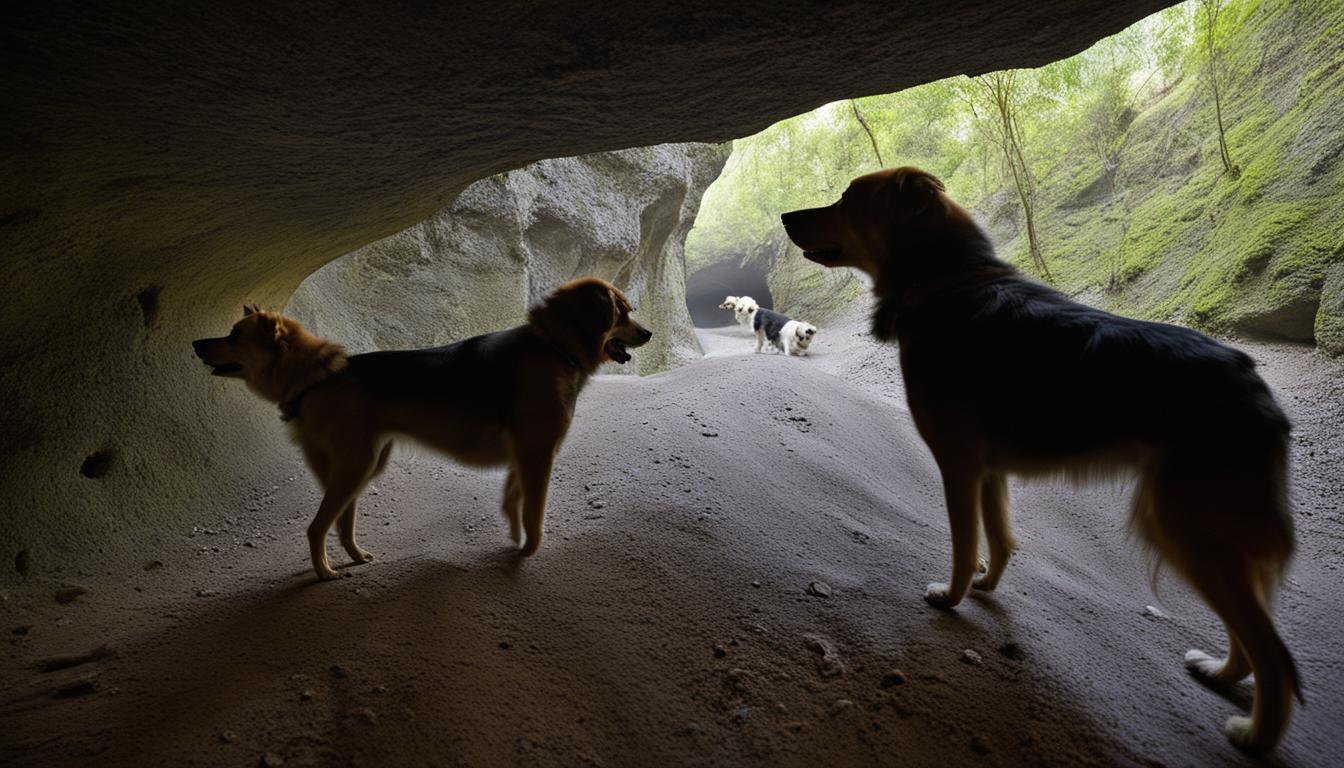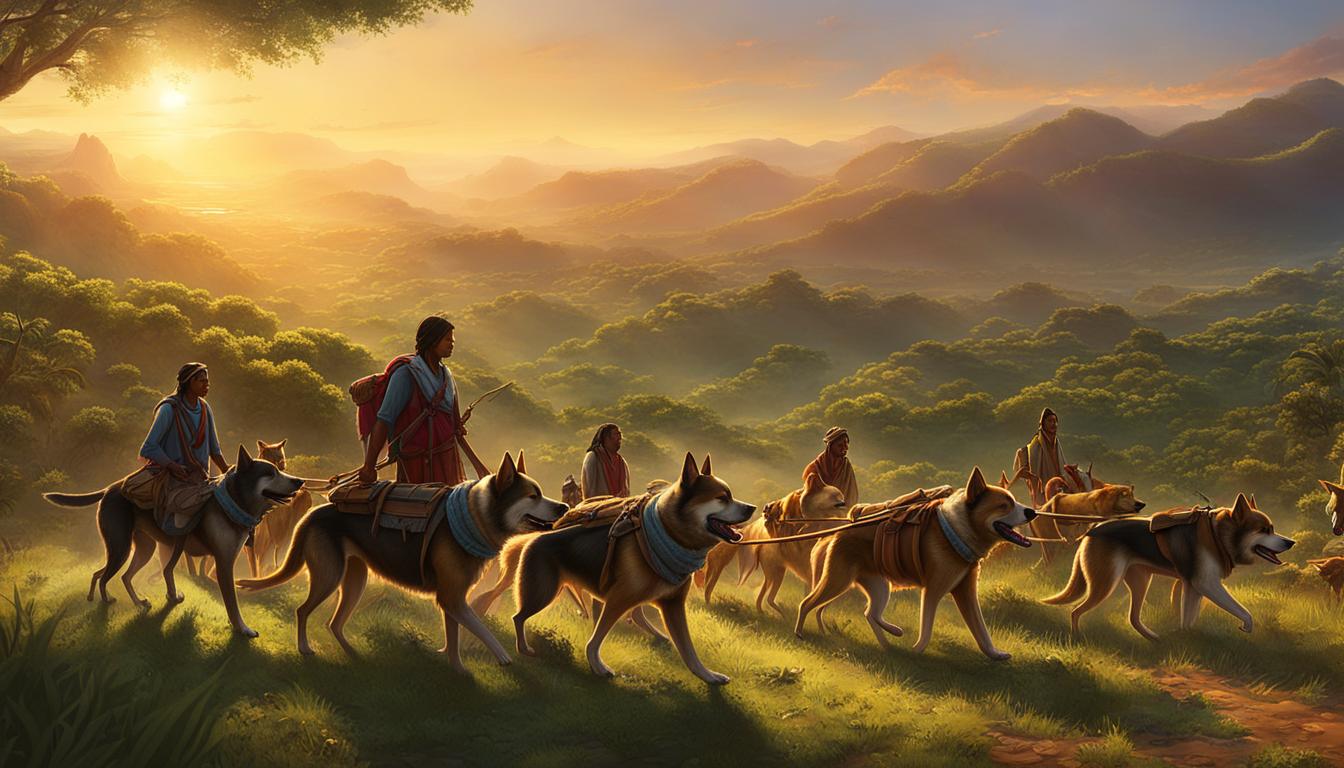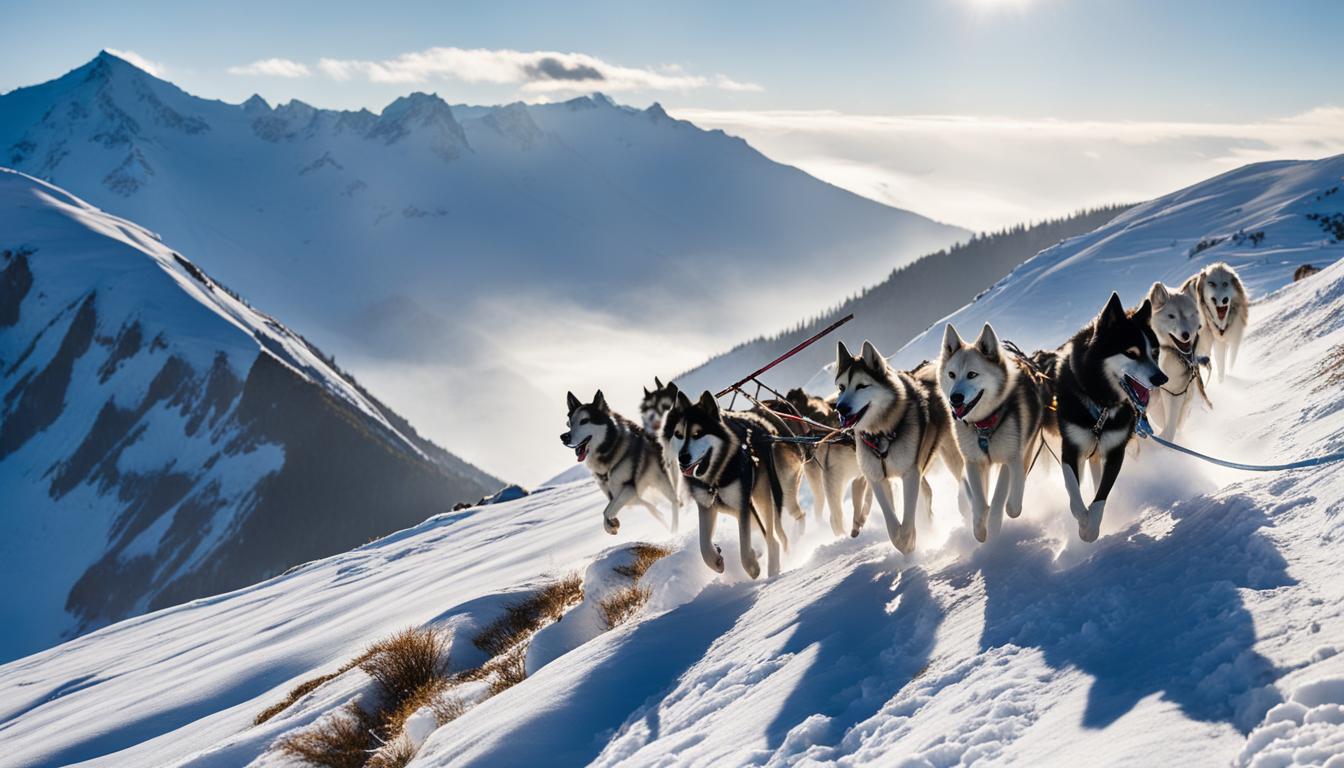Welcome, dog lovers! Prepare to embark on a journey through the enchanting tales of medieval dogs. These heartwarming stories will give you a glimpse into the extraordinary bond between humans and our loyal companions during the medieval era. From acts of bravery to tales of unwavering loyalty, dogs of the dark ages left an indelible mark on history. So, grab a comfortable seat and get ready to be captivated by the fascinating world of medieval dog stories.
Key Takeaways:
- Medieval dog stories showcase the deep connection between humans and canines during that time.
- Dogs played various roles in medieval society, including as companions, protectors, and even symbols of supernatural entities.
- The legend of the Black Dog, a mysterious creature associated with the medieval era, continues to intrigue and captivate audiences.
- Ancient Greece and Rome revered dogs as cherished companions, as evidenced by the touching epitaphs dedicated to departed dogs.
- The phrase “Love me, love my dog” originated in medieval times, emphasizing the importance of accepting and loving someone’s dog as an expression of unconditional love.
The Legend of the Black Dog
Step back in time to the medieval era and immerse yourself in the captivating legend of the Black Dog. This mysterious creature, often associated with supernatural powers, roamed the British and European countryside, leaving an indelible mark on the folklore and tales of the time. Described as a large, black, shaggy-coated dog, the Black Dog was known to be a guardian, a harbinger of misfortune, and even a malevolent presence. Its presence in medieval stories and legends cannot be ignored.
The Black Dog is steeped in symbolism and represents a potent mix of fear and intrigue. It is said to appear in moments of crisis or impending doom, serving as a foreboding omen. Yet, it also possesses a protective nature, guarding ancient landmarks and guiding lost souls. The Black Dog’s imposing presence and supernatural attributes have made it a subject of fascination and fear for centuries.
“And then, there was the Black Dog, with eyes as red as fire, haunting the villagers with its chilling howls.”
Legends of the Black Dog span across time and cultures, with tales dating back to the Middle Ages. In England, stories of the Black Dog are intertwined with local folklore, warning of its appearance as a premonition of tragedy or disaster. Other countries, such as Germany and Scandinavia, also have their own versions of the Black Dog legend, each with its unique twists and interpretations. These tales have captivated generations and continue to intrigue us with their supernatural allure.

Table: The Black Dog Legend in Different Cultures
| Country | Black Dog Interpretation |
|---|---|
| England | Omen of impending doom, protector of ancient sites |
| Germany | Symbol of death, guardian of hidden treasures |
| Scandinavia | Sign of imminent danger, associated with witchcraft |
The legend of the Black Dog continues to captivate our imagination, inspiring countless stories, poems, and even songs. Its presence in medieval times and beyond has left an enduring mark on popular culture, reminding us of the power of folklore and the grip it has on our collective consciousness. The Black Dog remains an enigmatic figure in the annals of history, forever tied to the mystique and intrigue of the medieval era.
Dogs as Companions in Ancient Greece and Rome
In the ancient civilizations of Greece and Rome, dogs were cherished companions and held a special place in the lives of their owners. Ancient epitaphs from this time reveal the deep emotional bond between humans and their faithful canine friends. These epitaphs, etched into stone and preserved throughout the centuries, speak of the grief and love felt for departed dogs, highlighting their significance in people’s lives.
The epitaphs found in ancient Greece and Rome offer a glimpse into the profound connection between humans and dogs. They serve as a testament to the enduring love and loyalty that dogs provided. These inscriptions often include heartfelt expressions of grief and gratitude, honoring the memory of beloved pets who brought joy and companionship to their owners’ lives.
In addition to serving as loyal companions, dogs in ancient Greece and Rome played important roles in society. They were valued for their protective instincts and were often utilized as guardians of homes, livestock, and even children. Dogs were also employed for hunting purposes, using their keen senses and agility to track down game.
The Emotional Bond Between Humans and Dogs
The epitaphs found in ancient Greece and Rome provide a fascinating glimpse into the emotional bond between humans and dogs during this time. They demonstrate the deep affection and admiration that people had for their four-legged companions. These inscriptions reveal the profound impact that dogs had on their owners’ lives, and the grief that was felt upon their passing.
“Farewell, faithful companion. Your loyalty and love will forever be cherished in our hearts.”
These heartfelt words engraved in stone serve as a testament to the enduring bond between humans and dogs throughout history. They remind us of the profound impact that dogs have on our lives and the unconditional love and companionship they provide.
Table: Dogs in Ancient Greece and Rome
| Dog Breeds | Roles in Society | Epitaph Examples |
|---|---|---|
| Maltese | Beloved companions | “You were a faithful friend. Rest in peace.” |
| Mastiff | Guardians and protectors | “Strong and loyal, you defended us until your last breath.” |
| Greyhound | Hunting and racing | “Swift and agile, you brought us joy in the chase.” |
These epitaphs, along with historical accounts and artwork, paint a vivid picture of the role dogs played in ancient Greek and Roman society. They were valued not only for their practical uses but also for the emotional connection they formed with their human companions. Dogs truly were cherished members of the family, and their memory lives on through these ancient inscriptions.
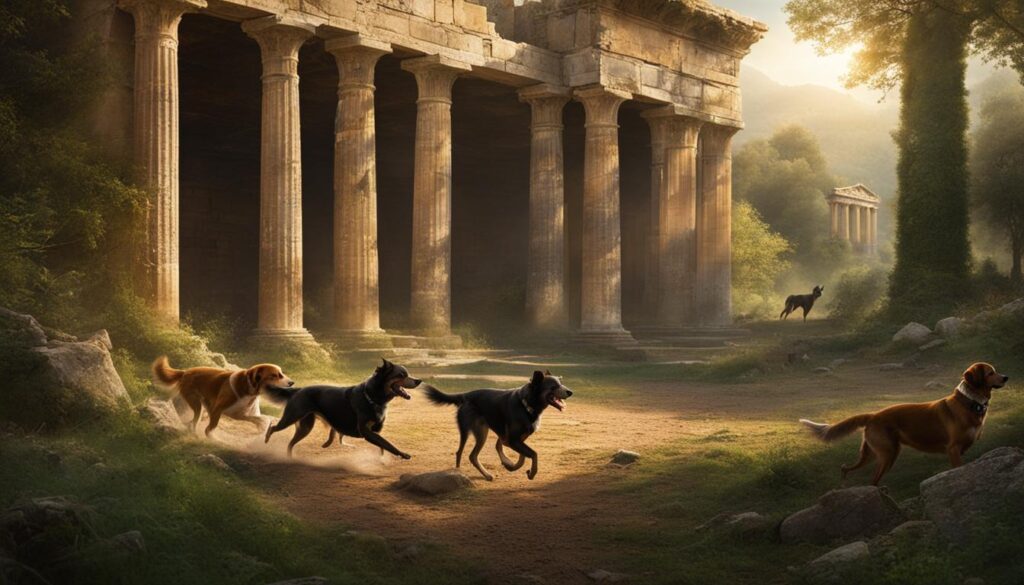
As we delve into the fascinating history of dogs during medieval times, it is essential to recognize the significance of dogs in ancient Greek and Roman civilizations. The bond between humans and dogs transcends time, and these ancient epitaphs serve as a testament to the enduring love and companionship that dogs have provided throughout the ages.
Love Me, Love My Dog: A Medieval Proverb
In medieval times, dogs held a special place in the hearts of their owners. They were not merely pets, but cherished companions who shared in their human counterparts’ triumphs and tribulations. This deep bond between humans and dogs is beautifully encapsulated in the medieval proverb, “Love me, love my dog.” This phrase, which predates the Middle Ages, emphasizes the importance of accepting and embracing someone’s dog as an integral part of their life, symbolizing unconditional love and acceptance.
Medieval French monk Saint Bernard of Clairvaux was one of the first to highlight the significance of this proverb. He believed that by accepting someone’s dog, you were showing love and respect for the person themselves. Dogs were seen as loyal and dedicated companions who provided unwavering support and unconditional love to their owners. By extension, accepting and loving someone’s dog was a way of showing acceptance and love for the person as well.
“Love me, love my dog” – Medieval Proverb
This medieval proverb reflects the deep emotional bond between humans and their canine companions during a time when dogs were considered valuable members of the household. Dogs played various roles in medieval society, from guarding the castle gates to providing comfort and companionship to knights and ladies. Their loyalty and bravery were admired and celebrated, and their presence brought warmth and joy to the lives of those they loved.
The Importance of Dogs in Medieval Society
In medieval society, dogs were not just pets; they were an integral part of everyday life. They provided practical assistance, such as hunting and herding, and were also valued for their companionship and protective instincts. Dogs were often depicted in medieval artwork, reflecting their prominent presence in medieval culture and society.
In addition to their practical roles, dogs held a significant place in medieval folklore and literature. They were often portrayed as loyal and courageous companions, accompanying knights on their noble quests. These stories emphasized the virtue of loyalty and the bond between humans and their dogs, further solidifying the importance of dogs in medieval society.
| Dog Breeds | Roles in Medieval Society | |
|---|---|---|
| 1 | Greyhound | Used for hunting deer and other game |
| 2 | Mastiff | Guarded castles and estates |
| 3 | Spaniel | Flushed out birds during hunts |
| 4 | Terrier | Used for vermin control |
The table above showcases some of the dog breeds that were commonly found in medieval society and their respective roles. Each breed had a specific purpose, whether it was hunting, guarding, or assisting with specific tasks. These dogs were valued for their abilities and were considered indispensable members of the household and society as a whole.
Overall, the medieval proverb “Love me, love my dog” serves as a testament to the profound bond between humans and dogs during the Middle Ages. It speaks to the importance of accepting and embracing not only the humans in our lives but also their beloved canine companions. Dogs played a vital role in medieval society, providing practical assistance and companionship, and their presence enriched the lives of those fortunate enough to share their journey.
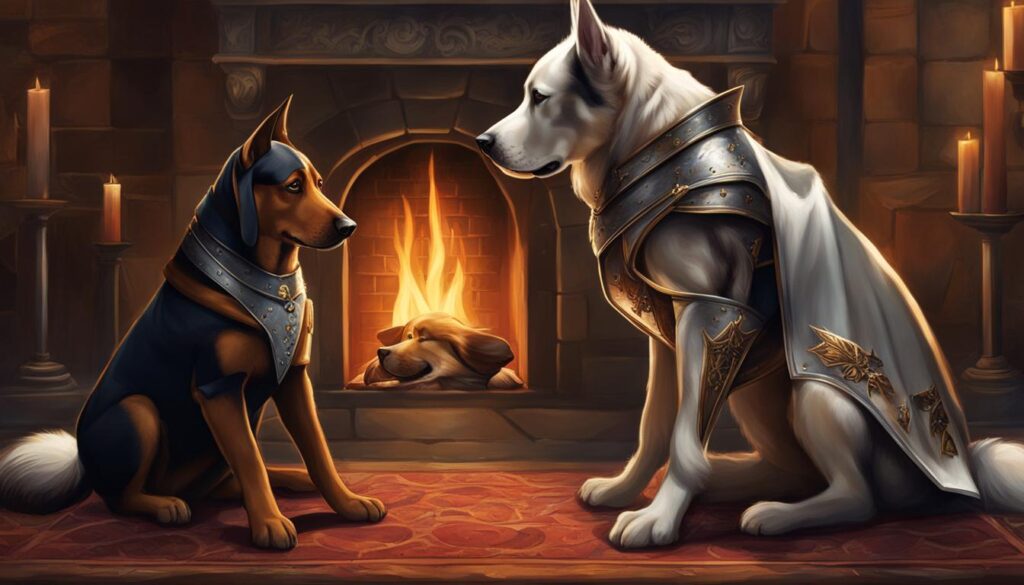
Dogs in Society: From Outcasts to Beloved Pets
During the Dark Ages, dogs were often seen as outcasts, dirty and disease-carrying creatures. They were not commonly kept as pets and were instead used for practical purposes such as hunting or guarding. However, as society progressed during medieval times, dogs began to be integrated into households as cherished companions and protectors.
As their role in society evolved, dogs started to play a more prominent role in medieval folklore. They became symbols of loyalty, bravery, and even supernatural entities. Stories and legends featuring dogs emerged, showcasing their unwavering loyalty to their human counterparts.
“A faithful dog will never leave your side, even in the darkest of times.”
These stories not only highlighted the bond between humans and dogs, but also their intelligence and ability to sense danger. Dogs were revered for their keen senses and their ability to protect their owners and their homes.
Dogs in Medieval Folklore
In medieval folklore, there were tales of faithful dogs who accompanied knights on their quests and adventures. These dogs were seen as companions and protectors, willing to lay down their lives for their masters. They were depicted as brave and loyal, embodying the virtues of chivalry and honor.
Additionally, dogs were believed to have supernatural powers in some folklore. There were stories of dogs that could see and interact with spirits, acting as guardians against evil forces. These beliefs further elevated the status of dogs in medieval society, from mere companions to mystical creatures.
| Role of Dogs in Medieval Society | Examples |
|---|---|
| Companionship | Knights and their loyal dogs embarking on epic quests |
| Protection | Dogs guarding castles and homes from intruders |
| Superstition | Dogs believed to have the ability to ward off evil spirits |
Through these stories and legends, dogs in medieval times transitioned from being outcasts to beloved pets. They became valued members of households and earned the love and admiration of their human companions.
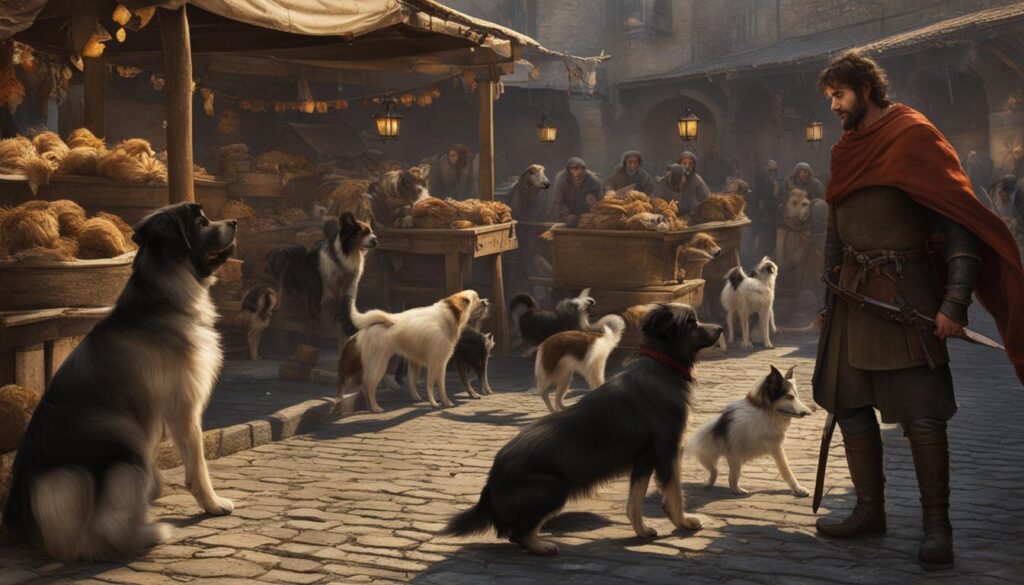
Conclusion
Medieval dog stories offer a captivating glimpse into the remarkable bond between humans and canines during this historical era. These tales reveal the unwavering loyalty, bravery, and companionship that dogs provided to their human counterparts. From the mystical legends of the Black Dog to the cherished companions of knights, the stories of medieval canines have left an indelible mark on history.
The tales of knights and their dogs are particularly captivating. These stories showcase the deep connection between knights and their loyal canine companions. From accompanying them on quests to defending them on the battlefield, dogs played an integral role in the lives of these valiant warriors. The tales of knights and their dogs remind us of the extraordinary bond that can exist between humans and animals.
Stories of medieval canines go beyond the realm of knights, however. They encompass a wide range of societal roles, from guard dogs protecting castles to dogs providing comfort and companionship to individuals from all walks of life. These stories depict dogs as more than just pets; they were valued members of society, offering their unwavering devotion and love to their human companions.
In conclusion, the tales of knights and their dogs, as well as the stories of medieval canines as a whole, provide us with a glimpse into a fascinating period in history. These tales remind us of the remarkable qualities possessed by dogs and the profound impact they can have on our lives. So, let us continue to celebrate and honor the extraordinary stories of medieval canines, forever inspired by their loyalty, bravery, and companionship.
FAQ
Were dogs popular pets during medieval times?
No, dogs were not commonly kept as pets during medieval times. They were often seen as dirty and disease-carrying creatures.
What was the role of dogs in ancient Greece and Rome?
In ancient Greece and Rome, dogs held a special place in the hearts of their owners. They were cherished companions and their deep emotional bond with humans is reflected in ancient epitaphs.
Where does the phrase “Love me, love my dog” come from?
The phrase “Love me, love my dog” originates from medieval times, but it predates this period. It highlights the importance of accepting someone’s dog as a way of showing unconditional love and acceptance.
What is the legend of the Black Dog?
The Black Dog is a mythical creature associated with the British and European countryside during medieval times. It is described as a large, black, shaggy-coated dog with supernatural powers and mysterious occurrences.
How did dogs go from being outcasts to beloved pets?
As society progressed, dogs started to be integrated into households as companions and protectors. They played a more prominent role in medieval folklore and became symbols of loyalty, bravery, and even supernatural entities.
What do medieval dog stories tell us?
Medieval dog stories provide a unique insight into the historical relationship between humans and dogs. They showcase the unwavering loyalty, bravery, and companionship that dogs offered during a time when their role in society was evolving.


